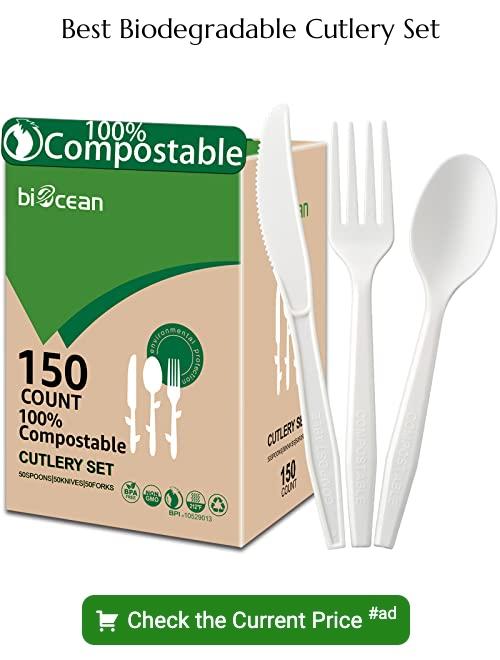Last updated on
Explore the world of eco-friendly alternatives to plastic utensils, promoting sustainability while meeting your dining needs.
Plastic utensils are convenient, lightweight, and disposable. However, they are also a major contributor to the world’s plastic pollution problem.
In fact, it is estimated that over 100 billion pieces of plastic utensils are thrown away every year in the United States alone! Fortunately, there are many alternatives to plastic utensils that not only look great but also help reduce waste. From bamboo to stainless steel and even edible options, this article will explore some creative ways to ditch the plastic and still enjoy your meals in style.
So let’s dive in!
Overview of Plastic Utensils

Plastic utensils have become a staple in our fast-paced, on-the-go lifestyles. They are lightweight, convenient, and readily available at restaurants and takeout joints.
However, it’s important to understand the impact that these seemingly harmless utensils have on our environment.
Made from non-biodegradable materials such as polypropylene or polystyrene, plastic utensils can take hundreds of years to decompose. This means that every plastic fork or spoon you use for just a few minutes will linger in landfills or end up polluting our oceans for centuries to come.
The production of plastic utensils also contributes significantly to carbon emissions and fossil fuel consumption. From extracting raw materials like petroleum or natural gas to the energy-intensive manufacturing processes involved, the environmental toll is substantial.
Moreover, there are health concerns associated with using certain types of plastic cutlery. Some plastics contain harmful chemicals like BPA (bisphenol A) which can leach into food when exposed to heat or acidic substances.
Considering all these factors together paints a grim picture of how single-use plastic cutlery impacts both our planet’s well-being and potentially even our own health.
The Environmental Impact of Plastic Utensils
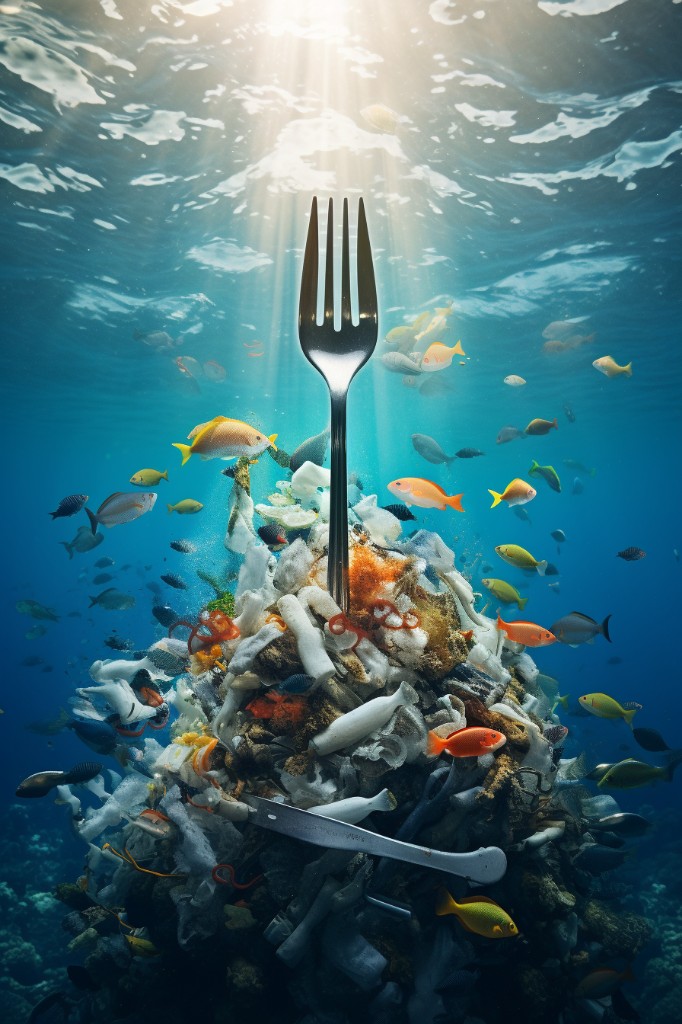
These single-use items are typically made from non-biodegradable materials like polystyrene or polypropylene, which means they can take hundreds of years to break down in landfills. As a result, plastic utensils contribute to the ever-growing problem of plastic pollution.
When disposed of improperly, plastic utensils often end up in our oceans and waterways. Marine animals mistake them for food or become entangled in them, leading to injury and death.
As plastics degrade over time into smaller microplastics, they enter the food chain and pose a threat not only to marine life but also potentially humans who consume seafood.
The production process for plastic utensils also has its own set of environmental concerns. It requires significant amounts of fossil fuels and energy resources while releasing greenhouse gases into the atmosphere during manufacturing.
Health Risks Associated With Plastic Utensils
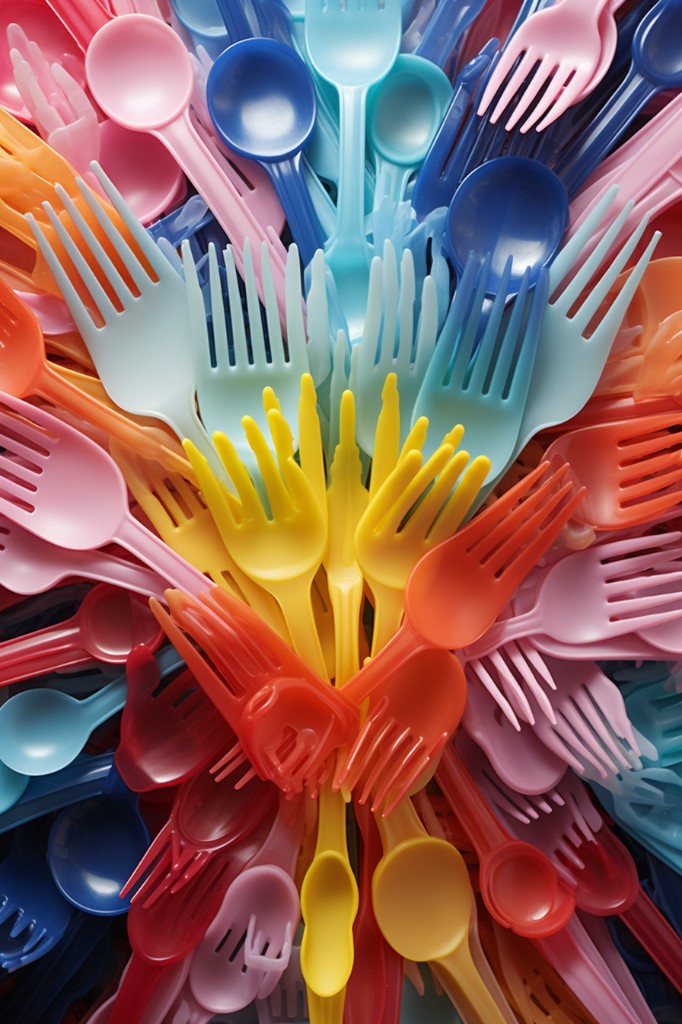
Plastic cutlery is typically made from materials like polystyrene or polypropylene, which can leach harmful chemicals into your food when exposed to heat or acidic substances.
One of the main concerns is the release of BPA (bisphenol A), a chemical commonly found in plastics. Studies have shown that BPA can disrupt hormone levels and potentially lead to various health issues such as reproductive problems, obesity, and even certain types of cancer.
Furthermore, when plastic utensils are scratched or damaged, they can harbor bacteria that are difficult to clean thoroughly. This poses a risk for foodborne illnesses if not properly sanitized between uses.
By opting for alternative materials like bamboo or stainless steel utensils instead of plastic ones, you reduce your exposure to these potential health hazards. These alternatives are generally considered safer options since they do not contain harmful chemicals and are easier to clean effectively.
Benefits and Limitations of Biodegradable Utensils
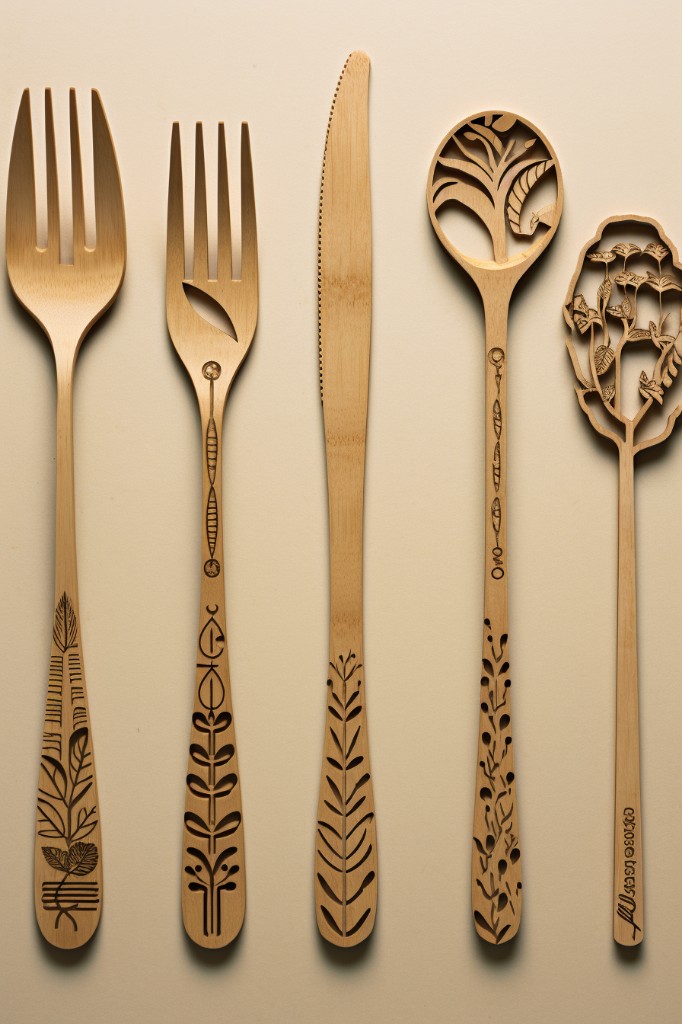
These utensils are typically made from plant-based materials such as cornstarch, wheat straw, or sugarcane bagasse. One of the key benefits of biodegradable utensils is their ability to break down naturally over time, reducing the environmental impact compared to traditional plastic options.
By choosing biodegradable cutlery, you can help minimize waste and prevent further pollution in our landfills and oceans. When disposed of properly in composting facilities or home compost bins, these utensils will decompose into organic matter without leaving behind harmful microplastics.
However, it’s important to note that there are limitations when it comes to using biodegradable utensils. While they offer an eco-friendly solution for single-use items like straws and stirrers, they may not be suitable for heavy-duty tasks like cutting through tough meats or handling hot foods due to their relatively lower durability compared to plastic or metal alternatives.
Some biodegradable materials require specific conditions (such as high temperatures) for proper decomposition which may not be readily available in all waste management systems. It’s crucial that consumers understand how and where these products should be disposed of correctly so that they can truly fulfill their environmentally friendly potential.
The Promise of Biodegradable and Compostable Cutlery
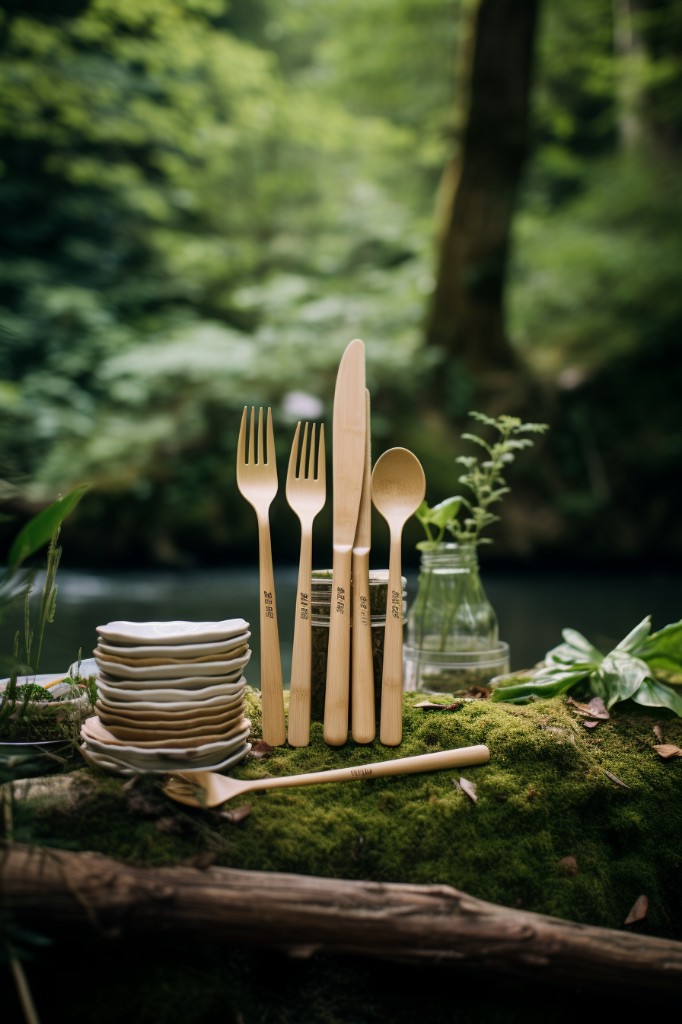
These innovative options are designed to break down naturally over time, reducing their impact on the environment. Made from materials such as plant starches, cornstarch, or even bioplastics derived from renewable resources like sugarcane or bamboo fibers, these utensils offer a guilt-free dining experience.
What makes biodegradable and compostable cutlery so appealing is that they can be disposed of in an environmentally friendly manner. When placed in a composting facility or home composter, these utensils will decompose into organic matter without releasing harmful toxins into the soil or waterways.
It’s important to note that not all products labeled as “biodegradable” are created equal. Look for certifications such as ASTM D6400 (for industrial compostability) or BPI certification (for both industrial and home compostability) when choosing your biodegradable cutlery.
While there are limitations to consider – some may have shorter lifespans than traditional plastic utensils – using them for picnics, parties, takeout meals can significantly reduce single-use plastic waste without compromising convenience.
Wooden Utensils As an Alternative
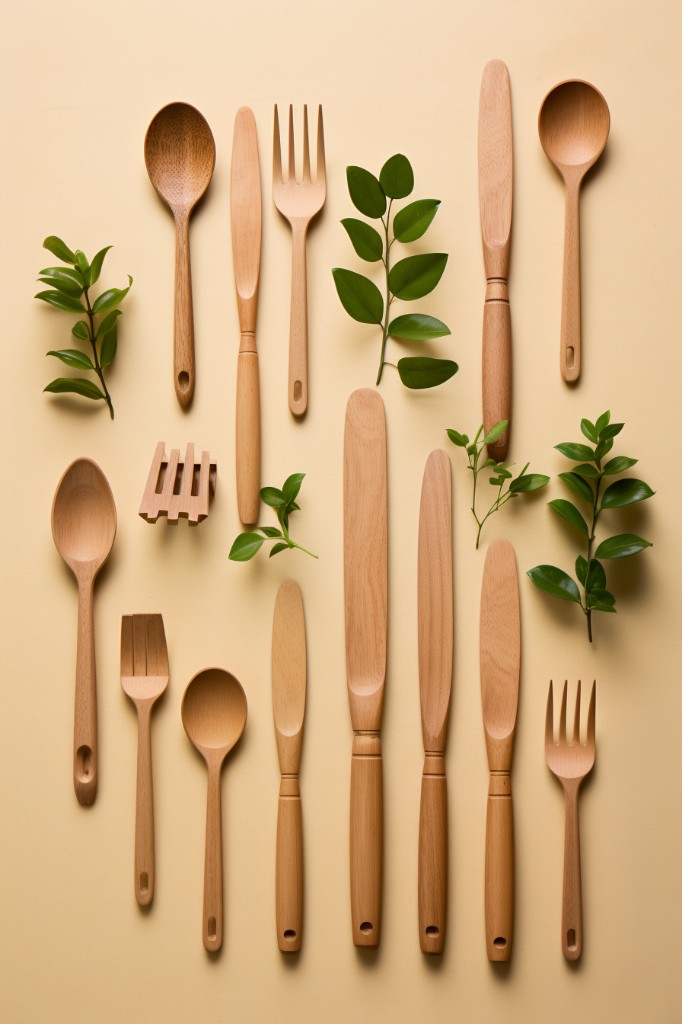
Not only do they add a touch of rustic charm to your dining experience, but they also offer several benefits that make them an excellent choice for eco-conscious individuals.
One of the key advantages of wooden utensils is their sustainability. Unlike plastic, which takes hundreds of years to decompose, wooden utensils are biodegradable and can be easily composted at the end of their life cycle.
This means that by opting for wooden alternatives, you’re actively reducing waste and minimizing your environmental footprint.
In addition to being environmentally friendly, wooden utensils are also durable and long-lasting. They may require some extra care compared to other materials like stainless steel or silicone but with proper maintenance (such as handwashing instead of using a dishwasher), they can withstand regular use without losing their functionality or aesthetic appeal.
Another great aspect is the natural feel that comes with using wooden cutlery. The smooth texture adds warmth and comfort while eating, enhancing your overall dining experience.
Plus, unlike metal alternatives that may get hot when exposed to high temperatures or cold when left in the fridge/freezer too long; wood remains relatively temperature-neutral making it comfortable on both warm summer days and chilly winter evenings.
When choosing wooden utensils as an alternative option in your kitchen arsenal consider looking out for sustainable sources such as bamboo or responsibly harvested hardwoods like birch or maple – ensuring minimal impact on forests during production processes.
Bamboo Utensils: A Sustainable Choice
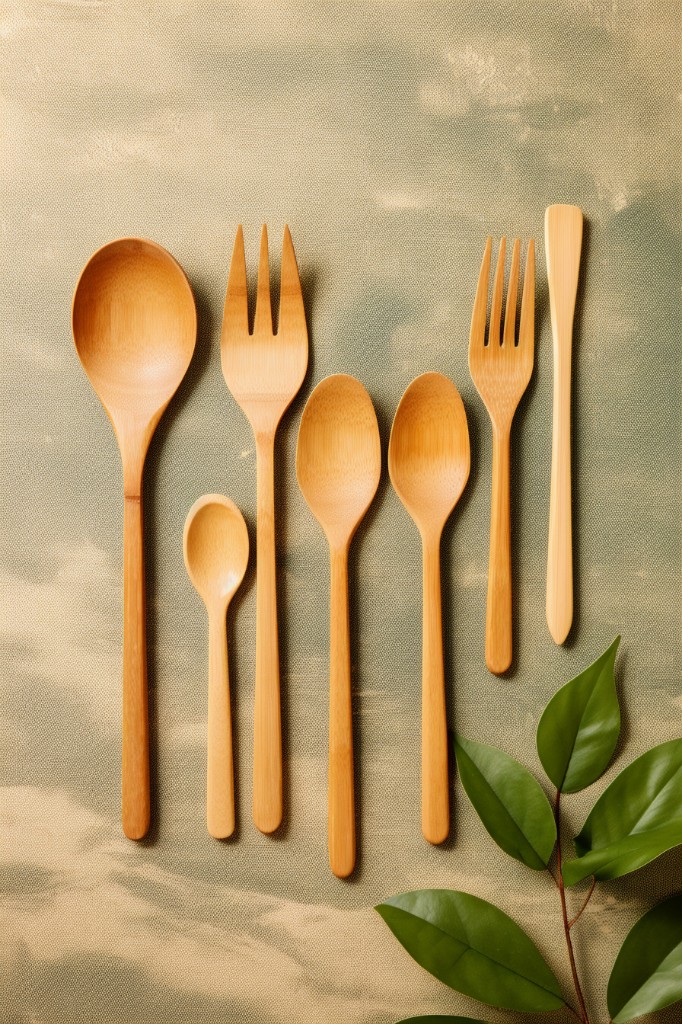
Bamboo is a fast-growing, renewable resource that requires minimal water and no pesticides or fertilizers to grow. Its natural strength and durability make it an excellent choice for utensils that can withstand everyday use.
Not only are bamboo utensils eco-friendly, but they also add a touch of elegance to your dining experience. With their smooth texture and beautiful grain patterns, bamboo cutlery brings a natural aesthetic appeal to any table setting.
One of the key advantages of using bamboo utensils is their lightweight nature, making them perfect for on-the-go meals or picnics in the park. They are easy to carry around in your bag without adding unnecessary weight.
Cleaning bamboo utensils is hassle-free too! Simply wash them with mild soap and warm water after each use, then allow them to air dry thoroughly before storing them away. Avoid soaking or putting them in the dishwasher as it may cause damage over time.
When it comes down to cost-effectiveness, investing in quality bamboo utensils can save you money in the long run compared to constantly buying disposable plastic cutlery packs.
Familiarizing With Bamboo Cutlery
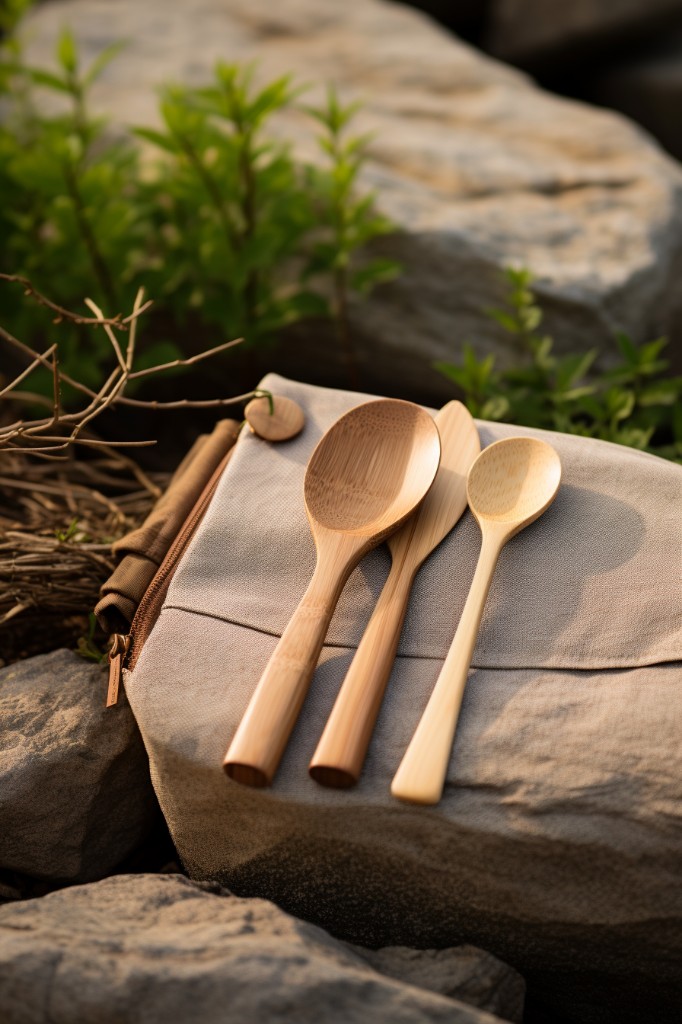
Not only is bamboo a fast-growing and renewable resource, but it also possesses natural antibacterial properties, making it an excellent choice for kitchenware.
Familiarizing yourself with bamboo cutlery is essential to understand its unique qualities. These utensils are lightweight yet sturdy, providing a comfortable grip while eating.
They come in various shapes and sizes, including spoons, forks, knives, chopsticks – everything you need for your dining experience.
One of the remarkable features of bamboo cutlery is its beautiful aesthetic appeal. The natural grain patterns give each piece a unique look that adds charm to any table setting or picnic spread.
To care for your bamboo utensils properly and prolong their lifespan:
- Hand wash them using mild soap and warm water.
- Avoid soaking them in water or exposing them to high heat.
- Periodically treat the utensils with food-safe oil (such as mineral oil) to maintain their smoothness and prevent cracking.
When you’re ready to dispose of your bamboo cutlery after years of use (which will be much longer than plastic alternatives), rest assured knowing they are biodegradable and compostable – returning back into nature without leaving behind harmful residues like plastics do.
Sugarcane Bagasse Cutlery: A Solution?

When it comes to finding sustainable alternatives to plastic utensils, sugarcane bagasse cutlery is gaining popularity for its eco-friendly qualities. Bagasse is the fibrous residue left behind after extracting juice from sugarcane stalks.
Traditionally, this byproduct was considered waste and often burned or discarded. However, innovative minds have found a way to transform bagasse into sturdy and functional cutlery.
By utilizing sugarcane bagasse as a raw material for utensils, we can reduce our reliance on single-use plastics while making use of an abundant agricultural waste product. These biodegradable and compostable utensils are not only environmentally friendly but also durable enough to handle various types of food.
One of the key advantages of using sugarcane bagasse cutlery is its natural resistance to heat and grease. Whether you’re enjoying piping hot soup or indulging in some greasy finger foods at a picnic, these utensils will hold up without any issues.
Moreover, they are free from harmful chemicals such as BPA (bisphenol A) that can leach into your food when using certain types of plasticware.
Edible Cutlery: An Innovative Approach
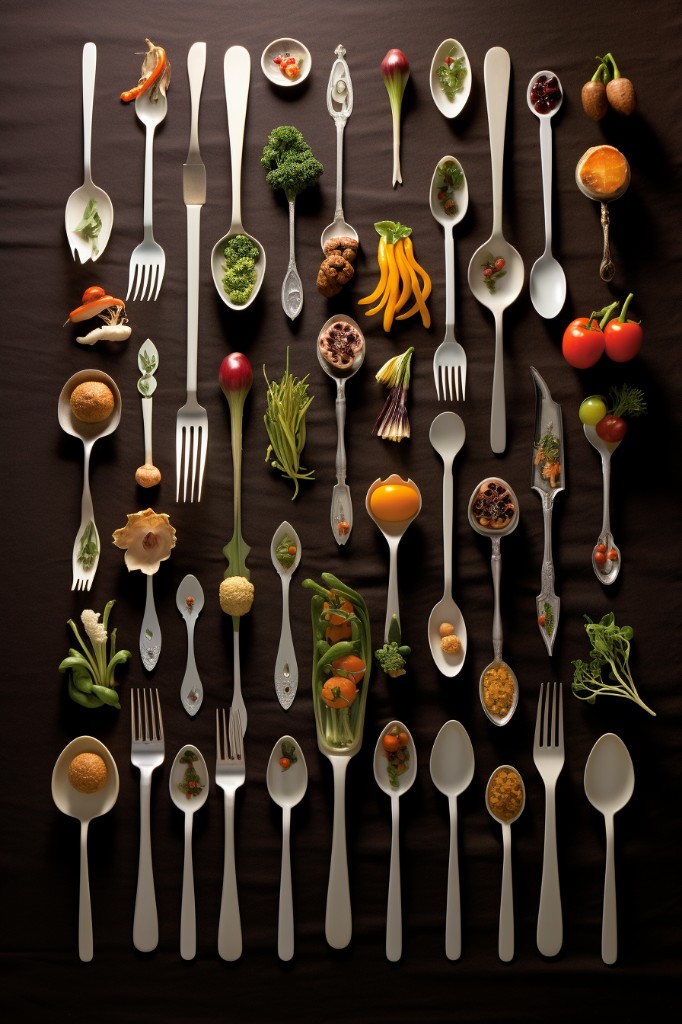
Yes, you read that right! Edible cutlery offers a unique approach to reducing waste while adding a touch of novelty to your dining experience.
Imagine enjoying your meal with utensils made from natural ingredients that are not only eco-friendly but also safe for consumption. These edible spoons, forks, and knives are typically crafted from materials like wheat flour or rice flour mixed with other grains or vegetables.
They come in various flavors such as plain, sweet, or savory – making them an exciting addition to any mealtime.
One of the key advantages of edible cutlery is its minimal environmental impact. Unlike plastic utensils that take hundreds of years to decompose (if they ever do), these edible options break down naturally within days if left uneaten or can be consumed after use without leaving behind any harmful residue.
Not only do they help reduce plastic waste in landfills and oceans but they also eliminate the need for energy-intensive recycling processes associated with traditional materials like metal or glass.
Moreover, using edible cutlery can be a fun conversation starter at parties and gatherings where sustainability is valued. Guests will surely appreciate this creative twist on tableware while indulging in guilt-free eating!
However, it’s important to note that there may be some limitations when it comes to durability compared to their non-edible counterparts. Depending on the brand and recipe used by manufacturers producing these biodegradable spoons (or forks), some may have shorter lifespans than others before becoming soggy when exposed too long in hot liquids like soups.
Nonetheless, edible cutlery remains an exciting alternative worth exploring. Whether you’re hosting an eco-conscious dinner party, packing lunchboxes, or simply looking for ways to make small changes towards sustainability, these tasty yet functional utensils offer both practicality and novelty.
The Intriguing Idea of Edible Jowar Spoons
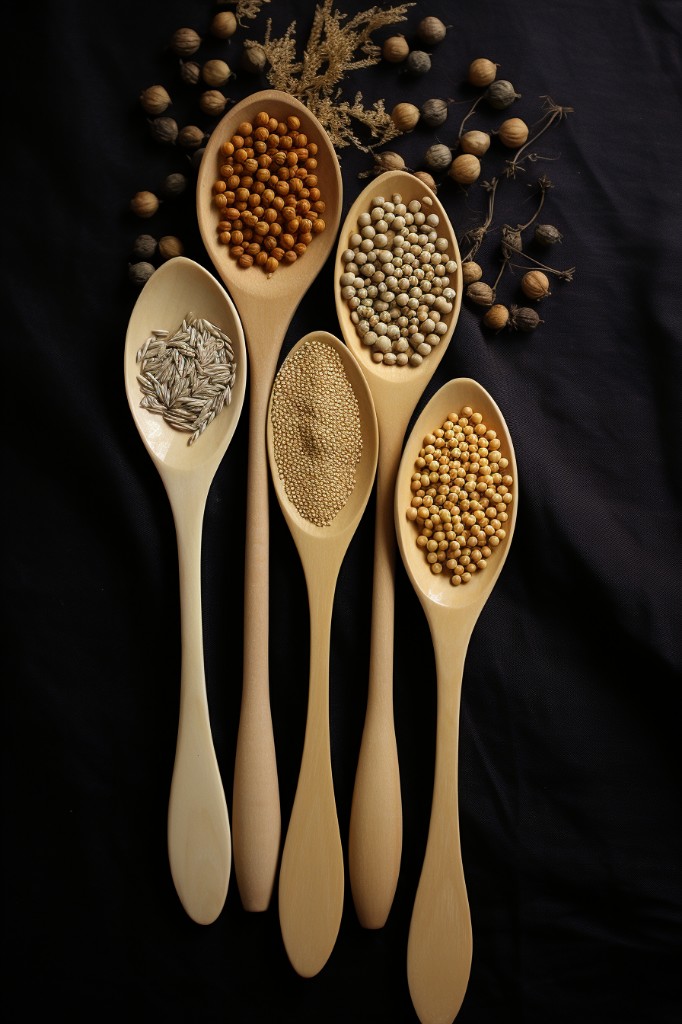
Edible jowar spoons are not only an eco-friendly alternative to plastic utensils but also offer a delightful twist to your dining experience.
Imagine indulging in a delicious bowl of soup and instead of reaching for a plastic spoon that will end up polluting our oceans or landfills, you can simply take a bite out of your edible jowar spoon! These spoons are made from ground jowar flour mixed with water and other natural ingredients. They are then baked until they become sturdy enough to hold their shape while still being completely edible.
The intriguing idea behind these edible spoons is that they eliminate the need for any waste disposal after use. You can enjoy your meal without contributing to environmental harm or cluttering up our already overflowing landfills.
Plus, since they’re made from natural ingredients like jowar flour, these spoons add an interesting flavor element when paired with different dishes.
Edible jowar spoons come in various flavors such as plain, sweetened with honey or infused with herbs and spices like garlic or chili flakes. This variety allows you to choose the perfect complement for whatever dish you’re enjoying – whether it’s savory soups or delectable desserts!
While some may argue that using an edible spoon might be less convenient than traditional options due to its limited durability (they do soften over time), it’s important to remember that sustainability often requires small sacrifices on our part. By opting for this innovative alternative whenever possible – at picnics, parties, food stalls – we contribute towards reducing single-use plastics significantly.
Exploring Stainless Steel Utensils
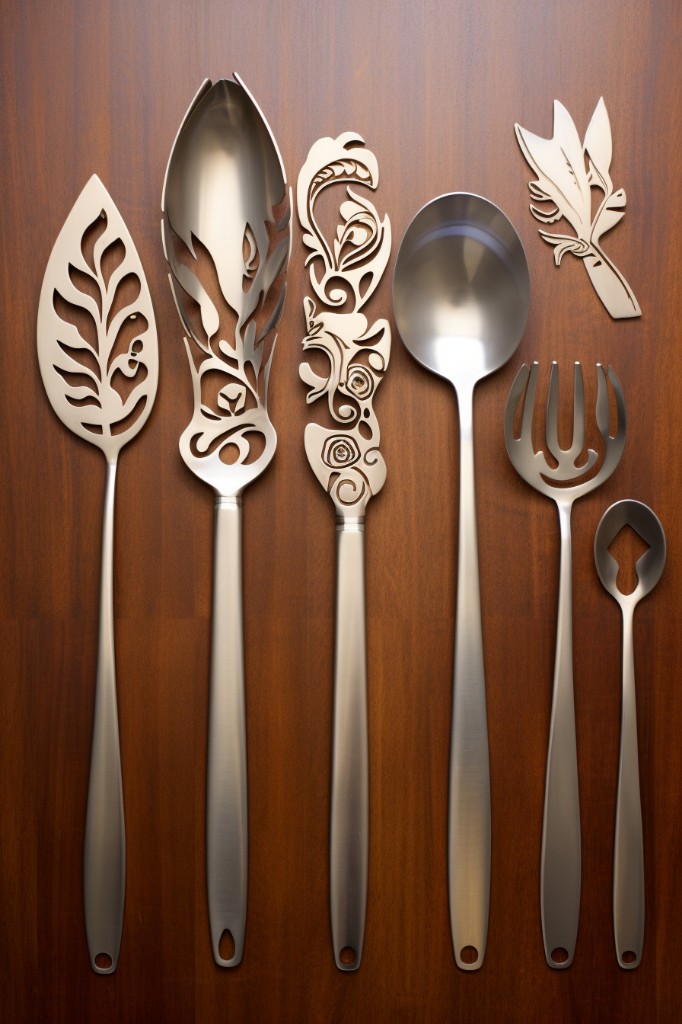
Not only are they durable and resistant to rust, but they also offer a sleek and modern aesthetic that can elevate any dining experience.
When it comes to sustainability, stainless steel utensils shine as well. Unlike plastic cutlery that ends up in landfills or oceans, stainless steel utensils can be used over and over again without losing their quality.
This means less waste being generated overall.
Another advantage of stainless steel is its versatility. From forks and spoons to knives and serving sets, there is a wide range of options available to suit your specific needs.
Whether you’re hosting an elegant dinner party or simply enjoying a casual meal at home with family, stainless steel utensils provide both functionality and style.
Cleaning stainless steel utensils is also hassle-free compared to other materials like wood or bamboo which require special care instructions. With just some soap water or even tossing them into the dishwasher (check manufacturer’s recommendations), your shiny set will be ready for use again in no time!
While investing in high-quality stainless-steel cutlery may seem more expensive upfront compared to disposable plastic alternatives, it’s important to consider the long-term benefits both environmentally-friendly aspects as well as durability-wise – these pieces will last you years if not decades! Plus think about all those single-use plastics saved from ending up polluting our planet!
Stylish Copper Utensils
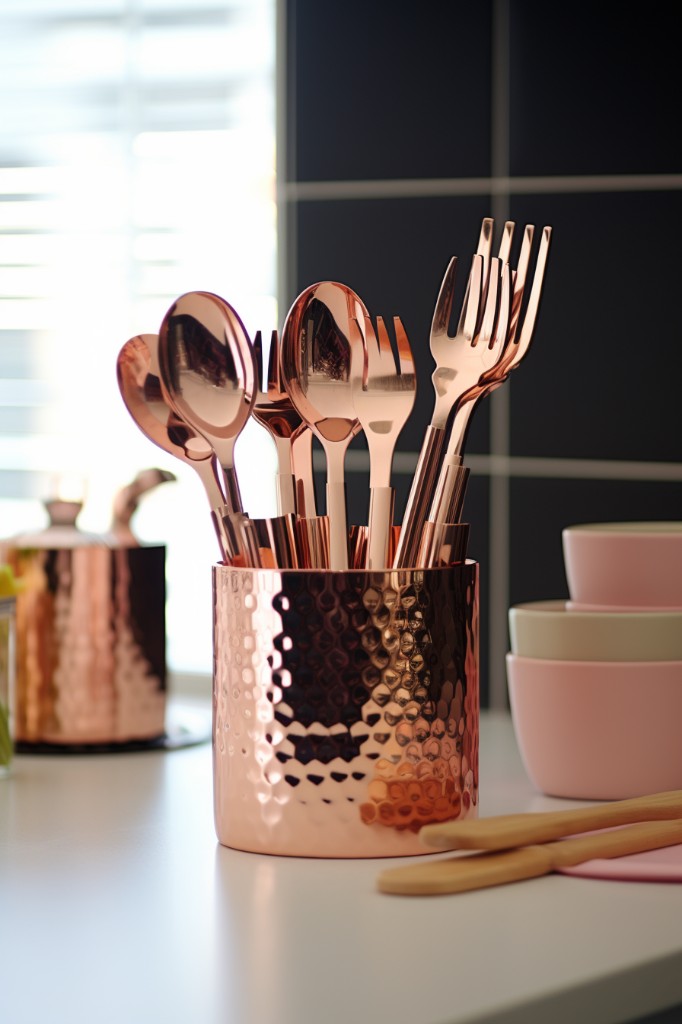
These stylish alternatives to plastic utensils are making a comeback in modern kitchens and dining spaces.
Known for its excellent heat conductivity, copper cookware has long been favored by professional chefs. But did you know that copper utensils can also elevate your table setting? With their warm, reddish-gold hue and sleek designs, they add a touch of elegance to any meal.
One of the advantages of using copper utensils is that they are incredibly durable. Unlike plastic cutlery that easily breaks or melts under high temperatures, copper stands the test of time.
Investing in quality copper pieces means you’ll have reliable kitchen companions that will last for years.
In addition to durability and aesthetics, there’s another reason why many people opt for stylish copper utensils: health benefits. Copper has natural antimicrobial properties which help inhibit the growth of bacteria on surfaces – including your eating tools! This makes them an excellent choice if hygiene is a top priority in your household.
When it comes to maintenance, caring for your beautiful copper utensils is relatively simple too! Regularly polishing them with specialized cleaners or even using natural methods like lemon juice and salt can keep them looking shiny and new.
Whether you’re hosting a fancy dinner party or simply want to add some flair to everyday meals at home, consider incorporating stylish copper utensils into your table setting collection.
Ease of Use: Silicone Utensils

Made from a flexible and heat-resistant material, silicone utensils offer several advantages over traditional plastic options.
One of the key benefits of silicone utensils is their durability. Unlike plastic, which can easily break or melt when exposed to high temperatures, silicone can withstand extreme heat without warping or melting.
This makes them ideal for use in hot pans or on grills.
The flexibility of silicone allows for easy maneuverability while cooking. Whether you’re flipping pancakes or stirring a pot of soup, these utensils provide excellent control and precision.
Another advantage is that they are non-stick friendly. Silicone’s smooth surface prevents scratching on delicate cookware surfaces such as non-stick pans and ceramic dishes.
Cleaning up after a meal becomes hassle-free with silicone utensils as well! They are dishwasher safe and resistant to stains and odors, making them incredibly low maintenance compared to other materials.
Furthermore, many manufacturers produce an array of vibrant colors when it comes to silicone kitchen tools – adding a fun pop of color into your culinary adventures!
While some may argue that using silicones contributes negatively towards environmental concerns due its synthetic nature; it’s important to note that they tend not degrade quickly like plastics do nor release harmful chemicals during usage (when used within recommended temperature ranges). Therefore if properly cared for – by reusing instead replacing frequently: they can be considered more sustainable than disposable plastic alternatives.
Porcelain Utensils: A Classic Alternative
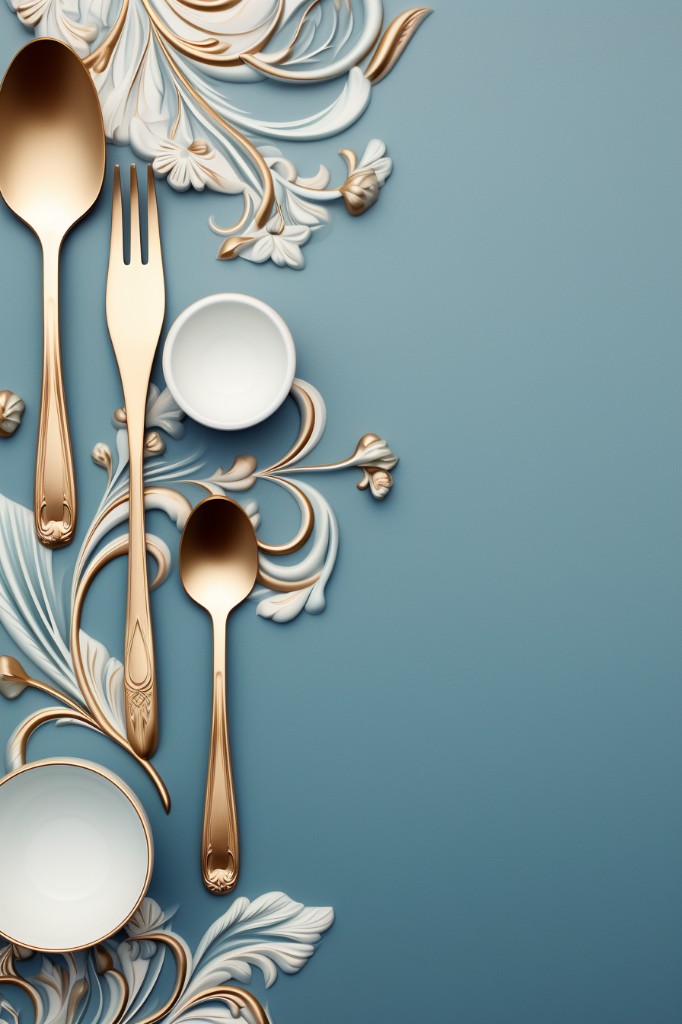
With their smooth texture, delicate designs, and timeless appeal, they can elevate any dining experience. Made from high-quality ceramic material fired at high temperatures, porcelain utensils are durable and long-lasting.
One of the key advantages of porcelain utensils is their versatility. They come in various shapes and sizes to suit different types of meals – from soup spoons for comforting bowls of hot soup to salad forks for lighter fare.
Whether you’re hosting a formal dinner party or enjoying a casual meal with loved ones, porcelain utensils add an air of sophistication to your table setting.
In addition to their aesthetic appeal, porcelain utensils are also practical in terms of functionality. They have excellent heat retention properties which make them ideal for serving hot dishes without worrying about them getting too hot to handle.
Porcelain is non-reactive as well, meaning it won’t affect the taste or quality of your food.
Cleaning porcelain utensils is relatively easy too! Most pieces are dishwasher-safe but be sure to check the manufacturer’s instructions before cleaning them this way as some delicate designs may require handwashing instead.
While purchasing new sets can be expensive upfront compared to disposable plastic options (include cost comparison section), investing in quality porcelain cutlery will save you money over time due its durability (mention benefits/limitations section). Plus, by choosing reusable alternatives like these beautiful pieces made from sustainable materials such as clay or kaolin (a type of white clay), you’re making an eco-conscious choice that helps reduce waste generated by single-use plastics.
Recycled Utensils: A Way Forward
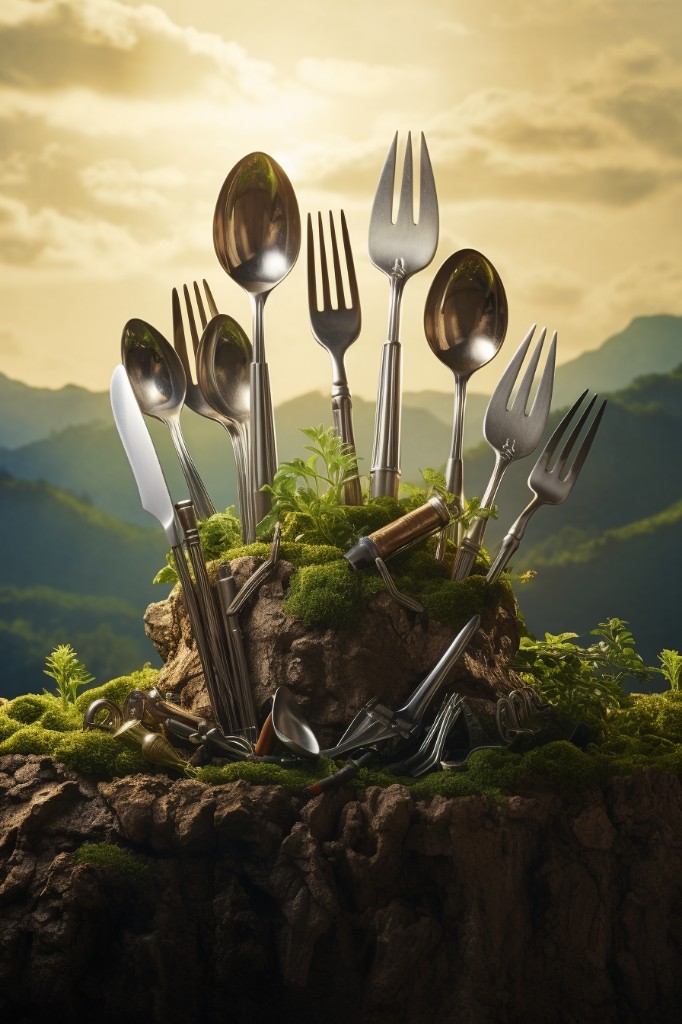
These innovative creations are made from materials that have been repurposed and given a new lease on life. By choosing recycled utensils, you not only reduce waste but also support the circular economy.
Recycled utensils come in various forms and materials. Some are crafted from reclaimed wood or bamboo scraps, while others are made from recycled plastics such as PET bottles or even old CDs! The manufacturing process involves transforming these discarded items into durable and functional cutlery.
One of the key advantages of using recycled utensils is their positive environmental impact. By diverting waste from landfills and reducing the need for virgin resources, they help conserve energy and minimize carbon emissions associated with production processes.
Moreover, these eco-friendly options often boast unique designs that add a touch of creativity to your dining experience. From colorful handles to textured patterns inspired by nature’s beauty, each piece tells its own story while contributing to a more sustainable future.
When considering recycled utensils as an alternative choice for your kitchen or dining table setup, it’s important to note that durability may vary depending on the specific material used in their construction. While some options may be sturdy enough for everyday use at home or picnics in the park; others might be better suited for occasional gatherings or events where aesthetics take precedence over long-term functionality.
Ultimately though if you’re looking for an environmentally conscious way forward without compromising style or practicality – exploring this avenue could prove both rewarding and inspiring!
Choosing the Best Alternative for Different Occasions

Each alternative has its own unique features and benefits that make them suitable for different situations.
For casual outdoor gatherings such as picnics or barbecues, bamboo utensils are a popular choice. They are lightweight, durable, and have a natural aesthetic that adds an earthy touch to your dining experience.
If you’re hosting a more formal dinner party or special event, stainless steel utensils can elevate the ambiance with their sleek and polished appearance. Not only do they look elegant on any table setting but they also offer long-lasting durability.
Silicone utensils are perfect for everyday use in busy households where convenience is key. They are heat-resistant and gentle on non-stick cookware while providing excellent grip during cooking tasks.
For those who appreciate vintage charm or want something truly unique, porcelain utensils can add a touch of elegance reminiscent of bygone eras. Their delicate designs make them ideal for fancy tea parties or intimate gatherings where aesthetics play an important role.
Recycled plastic alternatives deserve mention too! Made from post-consumer recycled materials like milk jugs or yogurt containers these options help reduce waste while still offering functionality at an affordable price point. Ultimately, selecting the best alternative depends on your personal preferences as well as considering factors such as durability requirements, ease of cleaning, and budget constraints.
By understanding each option’s strengths and limitations, you can choose wisely based on what suits your needs best.
Cost Comparisons: Plastic Vs Sustainable Alternatives
Many people assume that opting for eco-friendly alternatives to plastic utensils will break the bank. However, you’ll be pleasantly surprised to learn that there are affordable options available.
Let’s take a closer look at the cost comparisons between plastic utensils and their sustainable counterparts. While plastic cutlery may seem cheaper upfront, it’s important to consider the long-term costs associated with its environmental impact and frequent repurchasing.
Biodegradable utensils made from materials like cornstarch or sugarcane bagasse are becoming increasingly popular due to their affordability and eco-friendliness. These options offer similar functionality as traditional plastics but without harming the planet.
Bamboo cutlery is another budget-friendly alternative worth considering. Bamboo is a fast-growing plant that requires minimal resources for cultivation, making it an economical choice in terms of production costs.
Stainless steel utensils may have a higher initial price tag compared to disposable plastics; however, they can last for years with proper care and maintenance. This durability makes them more cost-effective in the long run since you won’t need constant replacements like with single-use plastics.
It’s also worth noting that some companies offer rental services for events or parties where reusable tableware can be rented at an affordable price per guest—a win-win situation both economically and environmentally!
How to Transition From Plastic to Sustainable Utensils
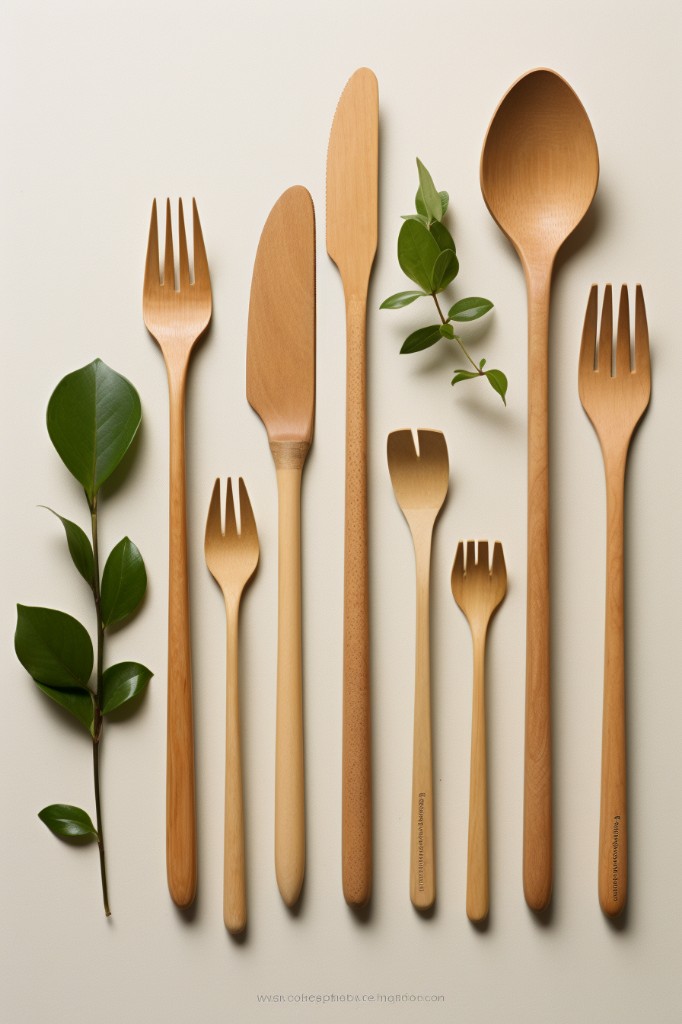
Here are some practical steps you can take to make the switch:
1. Assess your current utensil collection: Start by taking stock of your existing plastic utensils.
Determine which ones you use most frequently and prioritize replacing those first.
2. Research sustainable alternatives: Explore the various options available in terms of materials, such as bamboo, stainless steel, or even edible cutlery made from ingredients like sorghum or rice flour.
Consider factors like durability, ease of cleaning, and aesthetic appeal when making your decision.
3. Gradual replacement: Instead of throwing away all your plastic utensils at once (which would defeat the purpose), gradually replace them as they wear out or break over time.
4. Donate or repurpose: If you have excess plastic cutlery that is still in good condition but no longer needed for dining purposes (e.g., leftover party supplies), consider donating them to local schools or community centers where they could be put to use for crafts projects.
5.Store sustainably: Invest in eco-friendly storage solutions for your new sustainable utensils such as bamboo holders or fabric pouches instead of using disposable packaging options.
- Educate yourself on proper care instructions : Different materials require different care methods; educate yourself on how best to clean and maintain each type so that they last longer.
- Share with others : Spread awareness about the benefits of using sustainable alternatives by sharing information with friends,family,and social media followers.Encourage others around you also transition towards more environmentally friendly choices
Concluding Thoughts On Alternatives to Plastic Utensils
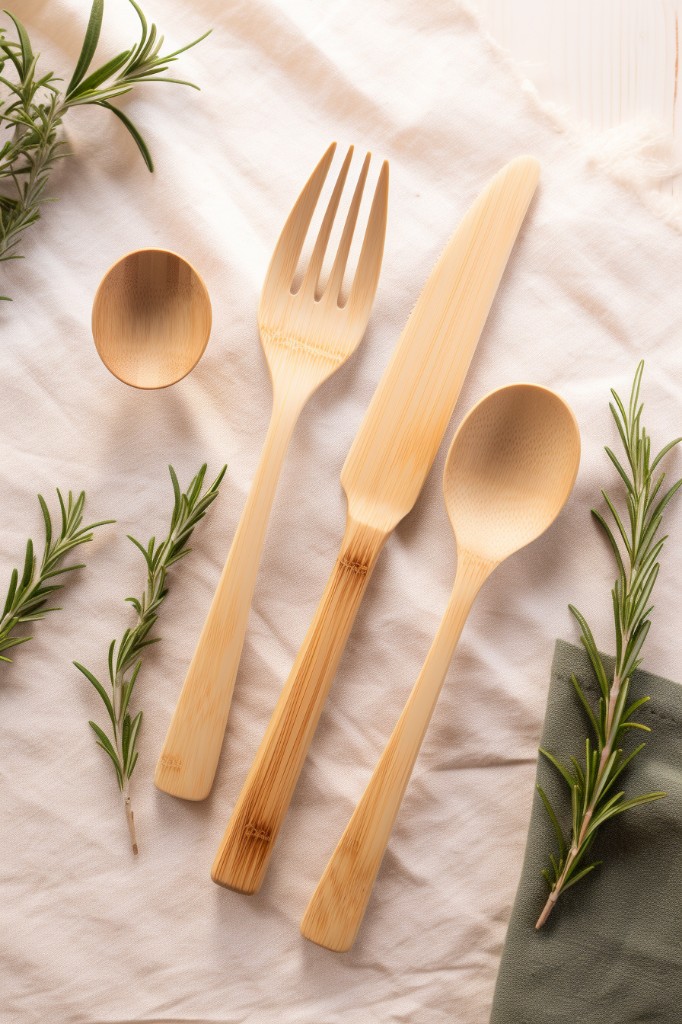
Whether you opt for bamboo, stainless steel, wooden cutlery or even edible options like jowar spoons, the choices are endless.
By making a conscious decision to switch from plastic utensils to sustainable alternatives, you’re taking an important step towards protecting our environment and reducing the amount of single-use plastics in circulation. Not only will this benefit our planet in the long run, but it can also inspire others around you to make similar changes.
When choosing your alternative utensils, consider factors such as durability and ease of use. Some materials may be more suitable for everyday use while others might be better suited for special occasions or outdoor events.
Keep in mind any specific dietary restrictions or preferences when exploring edible options.
Lastly—and perhaps most importantly—don’t forget about cost comparisons between plastic and sustainable alternatives. While some eco-friendly options may initially seem more expensive upfront than their disposable counterparts; they often prove themselves as worthwhile investments over time due to their longevity and reusability.
So why not embark on this journey towards sustainability? By embracing these alternative choices with open arms (and empty forks), we can all contribute positively towards creating a greener future—one meal at a time!
FAQ
What is the alternative to plastic knives and forks?
The alternative to plastic knives and forks is metal cutlery, which can be used hundreds of times, easily washed after use, and recycled at the end of its life, hence reducing environmental impact.
What is the best material for disposable cutlery?
The best material for disposable cutlery is polypropylene due to its flexibility, strength, and heat tolerance of 250℉ before distortion.
Are plastic utensils unhealthy?
Yes, plastic utensils can be unhealthy as using them in high-temperature cooking forms PAHs, exposure to which, particularly in the long-term or in large amounts, may cause health issues including cataracts, kidney and liver damage, and jaicundice.
How does the sustainability of bamboo utensils compare to plastic ones?
Compared to plastic ones, bamboo utensils are more sustainable due to bamboo’s quick growth rate and biodegradable nature.
What are the environmental impacts of using wooden utensils versus plastic ones?
Wooden utensils are generally more environmentally friendly than plastic ones as they are biodegradable and renewable, unlike plastic which contributes to pollution and global warming.
Are biodegradable utensils a viable alternative to plastic cutlery in terms of cost and durability?
Yes, biodegradable utensils can be a viable alternative to plastic cutlery in terms of cost and durability.
Recap
